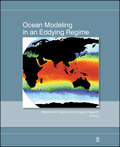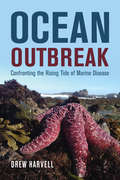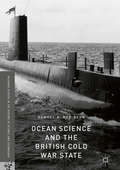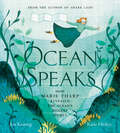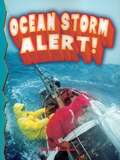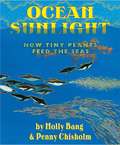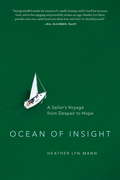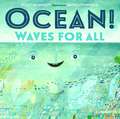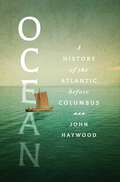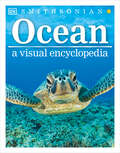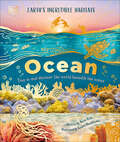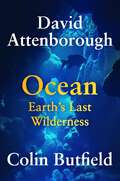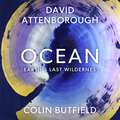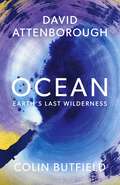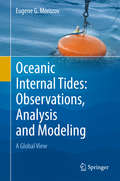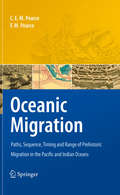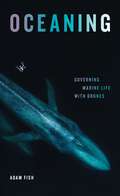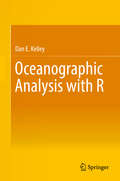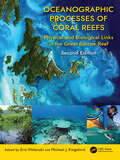- Table View
- List View
Ocean Modeling in an Eddying Regime
by Matthew W. Hecht Hiroyasu HasumiPublished by the American Geophysical Union as part of the Geophysical Monograph Series, Volume 177. <P><P> This monograph is the first to survey progress in realistic simulation in a strongly eddying regime made possible by recent increases in computational capability. Its contributors comprise the leading researchers in this important and constantly evolving field. Divided into three parts Oceanographic Processes and Regimes: Fundamental Questions Ocean Dynamics and State: From Regional to Global Scale, and Modeling at the Mesoscale: State of the Art and Future Directions The volume details important advances in physical oceanography based on eddy resolving ocean modeling. It captures the state of the art and discusses issues that ocean modelers must consider in order to effectively contribute to advancing current knowledge, from subtleties of the underlying fluid dynamical equations to meaningful comparison with oceanographic observations and leading-edge model development. It summarizes many of the important results which have emerged from ocean modeling in an eddying regime, for those interested broadly in the physical science. More technical topics are intended to address the concerns of those actively working in the field.
Ocean Outbreak: Confronting the Rising Tide of Marine Disease
by Drew HarvellThere is a growing crisis in our oceans as rates of infectious disease outbreaks are on the rise. Marine epidemics have the potential to cause a mass die-off of wildlife from the bottom to the top of the food chain, impacting the health of ocean ecosystems as well as lives on land. Fueled by sewage dumping, unregulated aquaculture, and drifting plastic in warming seas, ocean outbreaks are sentinels of impending global environmental disaster. Ocean Outbreak follows renowned scientist Drew Harvell and her colleagues as they investigate how four iconic marine animals—corals, abalone, salmon, and starfish—have been devastated by disease. Based on over twenty years of research, this firsthand account of the sometimes creeping, sometimes exploding impact of disease on our ocean’s biodiversity ends with a hopeful message. Through policy changes and the implementation of innovative solutions from nature, we can reduce major outbreaks, save some ocean ecosystems, and protect our fragile environment.
Ocean Science and the British Cold War State (Palgrave Studies in the History of Science and Technology)
by Samuel A. RobinsonThis book focuses on the activities of the scientific staff of the British National Institute of Oceanography during the Cold War. Revealing how issues such as intelligence gathering, environmental surveillance, the identification of ‘enemy science’, along with administrative practice informed and influenced the Institute’s Cold War program. In turn, this program helped shape decisions taken by Government, military and the civil service towards science in post-war Britain. This was not simply a case of government ministers choosing to patronize particular scientists, but a relationship between politics and science that profoundly impacted on the future of ocean science in Britain.
Ocean Speaks: How Marie Tharp Revealed the Ocean's Biggest Secret
by Jess KeatingMeet Marie Tharp (1920-2006), the first person to map the Earth's underwater mountain ridge, in this inspiring picture book biography from the author of Shark Lady.From a young age, Marie Tharp loved watching the world. She loved solving problems. And she loved pushing the limits of what girls and women were expected to do and be. In the mid-twentieth century, women were not welcome in the sciences, but Marie was tenacious. She got a job at a laboratory in New York. But then she faced another barrior: women were not allowed on the research ships (they were considered bad luck on boats). So instead, Marie stayed back and dove deep into the data her colleagues recorded. She mapped point after point and slowly revealed a deep rift valley in the ocean floor. At first the scientific community refused to believe her, but her evidence was irrefutable. She proved to the world that her research was correct. The mid-ocean ridge that Marie discovered is the single largest geographic feature on the planet, and she mapped it all from her small, cramped office.
Ocean Storm Alert!
by Carrie GleasonOver the oceans, no one is safe from the surging power of ocean storms. Ocean Storm Alert! looks at how whirlpools, tidal waves, and tsunamis start, and their effect on people at sea and in coastal areas.
Ocean Sunlight: How Tiny Plants Feed the Seas (Sunlight Series)
by Molly Bang Penny ChisholmIn this timely book, acclaimed Caldecott artist Molly Bang and award-winning M.I.T. professor Penny Chisholm use poetic language and dazzling illustrations to introduce the oceanic world. From tiny aquatic plants to the biggest whale or fish, Bang and Chisholm present a moving, living picture of the miraculous balance sustaining each life cycle and food chain deep within our wondrous oceans. <P><P>On land or in the deep blue sea, we are all connected--and we are all a part of a grand living landscape. Award-winning scientist Penny Chisholm, a leading expert on oceans, packs <i>Ocean Sunlight</i> with clear, simple science, illuminated by Molly Bang's wondrous illustrations. This informative, joyous book will help children understand and celebrate the astonishing role our oceans play in human life.
Ocean Sustainability in the 21st Century
by Salvatore AricòDescribing the emerging and unresolved issues related to the oceans and the marine environment, this book presents the developments made in marine science and policy since the implementation of the United Nations Convention on the Law of the Sea (UNCLOS), and implications for the sustainable management of ocean areas and resources. This comprehensive volume also provides a number of scientific, policy, and legal tools to address such issues, and to ensure better science-based management of the oceans. Topics covered include the impacts of human-induced climate change on the oceans, the marine genetic resources debate, the current legal framework for the oceans, and a comparative study of the legal issues associated with outer space. Including practical examples and worldwide case studies, this book is a valuable resource for policy makers, students and academics, in marine science and policy, ocean affairs, and the law of the sea.
Ocean in the Earth System
by Patrick Prouzet André MonacoComplexity is an intrinsic property of natural systems. In the oceanic system, it is linked to many interactions with the atmosphere, geosphere and biosphere with which it exchanges energy and matter.Complexity of the ocean system has, at different spatial and temporal scales, hydrodynamic mechanisms of these exchanges and dynamics of elements and compounds, they are involved in biogeochemical cycles or used as tracers.By its pedagogical approach, it defines the terms, methods, techniques and analytical tools used. Then, it analyzes the consequences of climate change, future projections, human impact and the concept introduced with planktonic pelagic ecosystem component
Ocean of Insight: A Sailor's Voyage from Despair to Hope
by Heather Lyn MannHeather Lyn Mann was a battle-weary environmental advocate in Madison, Wisconsin, struggling over what to do about climate change when she and her husband decided to explore the Atlantic on a small sloop. This memoir of six years living afloat is a chronological unfolding of disasters and discoveries--life-threatening storms, the boredom of isolation, societies on the brink of extinction, sinking ships, colorful Caribbean characters, near collisions, a pirate scare, and more. Throughout, the ocean becomes Mann's teacher, transforming her with uncompromising lessons on how to harmonize with natural order, the exact moments and ways to let in fearlessness, resilience, happiness, impermanence, balance, compassion, skillful action, and beginner's mind. Her suspenseful, sometimes hilarious, and always heart-warming journey of body and mind, shaped by ancient Buddhist teachings, entertains as it charts reality's depths and danger zones so arm-chair adventurers, spiritual seekers, and the climate concerned can navigate tumultuous waters and arrive together on the shore of planetary well-being.From the Trade Paperback edition.
Ocean! Waves for All (Our Universe #4)
by Stacy McAnultyFrom writer Stacy McAnulty and illustrator David Litchfield, Ocean! Waves for All is a light-hearted nonfiction picture book about the formation and history of the ocean, told from the perspective of the ocean itself.Dude. Ocean is incredible. Atlantic, Pacific, Artic, Indian, Southern—it's all excellent Ocean! Not part of any nation, his waves are for all. And under those waves, man, he holds so many secrets. With characteristic humor and charm, Stacy McAnulty channels the voice of Ocean in this next "autobiography" in the Our Universe series. Rich with kid-friendly facts and beautifully brought to life by David Litchfield, this is an equally charming and irresistible companion to Earth! My First 4.54 Billion Years; Sun! One in a Billion; and Moon! Earth's Best Friend.
Ocean, Atmosphere, and Climate: Cold Years in New Zealand, Investigation Notebook with Article Compilation
by The Lawrence Hall of ScienceNIMAC-sourced textbook
Ocean-Atmosphere Interactions of Gases and Particles (Springer Earth System Sciences)
by Peter S. Liss Martin T. JohnsonThe oceans and atmosphere interact through various processes, including the transfer of momentum, heat, gases and particles. In this book leading international experts come together to provide a state-of-the-art account of these exchanges and their role in the Earth-system, with particular focus on gases and particles. Chapters in the book cover: i) the ocean-atmosphere exchange of short-lived trace gases; ii) mechanisms and models of interfacial exchange (including transfer velocity parameterisations); iii) ocean-atmosphere exchange of the greenhouse gases carbon dioxide, methane and nitrous oxide; iv) ocean atmosphere exchange of particles and v) current and future data collection and synthesis efforts. The scope of the book extends to the biogeochemical responses to emitted / deposited material and interactions and feedbacks in the wider Earth-system context. This work constitutes a highly detailed synthesis and reference; of interest to higher-level university students (Masters, PhD) and researchers in ocean-atmosphere interactions and related fields (Earth-system science, marine / atmospheric biogeochemistry / climate). Production of this book was supported and funded by the EU COST Action 735 and coordinated by the International SOLAS (Surface Ocean- Lower Atmosphere Study) project office.
Ocean: A History of the Atlantic Before Columbus
by John HaywoodA magisterial cultural history of the Atlantic Ocean before Columbus, ranging from the early shaping of the continents and the emergence of homo sapiens to the story of shipbuilding, navigation, maritime exploration, slavery, and nascent European imperialism.A dazzling and ambitious history of the pre-Columbian Atlantic seas, Ocean is a story that begins with the formation of the mid-Atlantic ridge some 200 million years ago and ends with the Castilian conquest of the Canary Islands in the fifteenth century, providing a template for the methods used by the Spanish in their colonization of the New World. John Haywood eloquently argues that the perception of Atlantic history beginning with the first voyage of the celebrated Genoese navigator Christopher Columbus is a mistaken one, and that the seafaring and shipbuilding skills that enabled European global exploration and expansion did not arrive fully formed in the fifteenth century, but instead were learned over centuries and millennia in the Atlantic and its peripheral seas. The pre-Columbian history of the Atlantic is the story of how Europeans learned to master the oceans. This story is, therefore, key to understanding why it was Europeans, and not any of the world's other seafaring peoples, who &“discovered&” the world. Informed by the author's extensive travels around the Atlantic Ocean, crossing Newfoundland's Grand Banks, the Sea of Darkness, and the weed-covered Sargasso Sea, and populated by a heterogeneous and multiethnic cast of seafarers, fishermen, monks, merchants, and dreamers, Ocean is an in-depth history of a neglected subject, fusing geology, geography, mythology, developing maritime technologies, and the early history of exploration to narrate an enthralling an story—one which lies at the very heart of Europe's modern history and its relationship with the rest of the world.
Ocean: A Visual Encyclopedia (DK Children's Visual Encyclopedias)
by John Woodward DKFrom the shimmering surface to the darkest depths, this breathtaking visual encyclopedia presents our blue planet as never before. Stunning photography, accessible information, and fascinating facts are spilling over in this essential guide to the oceans. Take a dip in all the world&’s waters to experience their incredible diversity. Make a splash in the icy Arctic waters before warming up in the tropical Indian Ocean. Experience the super size of mighty whales compared to swarms of tiny krill. Cast your eyes to the skies to see circling sea birds before diving down to meet mysterious creatures of the deep. Awash with comprehensive information and fascinating detail, Ocean: A Children&’s Encyclopedia is the perfect choice for school projects, marine enthusiasts, and water babies everywhere.
Ocean: Dive in and Discover the World Beneath the Waves (Earth's Incredible Habitats)
by Annie RothTake children on a grand tour of the marine world in this striking book all about oceans. From the deepest known sea trench on Earth to the underwater forests that make their home in the Pacific Ocean, discover 10 of the world’s most spectacular ocean habitats, and the animals and plants that live in them in this beautiful gift book for children.This fascinating book on oceans offers:The second in a series of 4 books that takes children on a grand tour around the different habitats of the world.Everything you could want to know about habitats; the animals and plants that live there, the geography of the area, and plenty of incredible factsA giftable book with foil on the cover and edges, plus beautiful illustrations and photographs on every page.The chapters in this exciting anthology cover four different types of ocean habitat: open oceans, coral reefs, underwater forests, and the deep sea, with a selection of both famous and lesser-known places explored. Every marine environment is examined in detail, with intriguing information about its geography, and flora and fauna alongside detailed photography and beautiful illustrations. Children can marvel at fire coral in the Red Sea, sea spiders that thrive in the ghostly quiet of the Southern Ocean, and sea anemones that can live forever. As well as the wonders of these places, the threats facing oceans and their species are also investigated.More in the seriesThe Habitats series takes children on a grand tour of the different natural environments of the world, exploring animals, landforms and geography. If you enjoyed Ocean, why not try Mountain and learn about some of the earth’s most incredible landforms and the science behind them?
Ocean: Earth's Last Wilderness
by Sir David Attenborough Colin ButfieldAward-winning broadcaster and natural historian David Attenborough and longtime collaborator Colin Butfield present a powerful call to action focused on our planet's oceans, exploring how critical this habitat is for the survival of humanity and the earth's future. Through personal stories, history and cutting-edge science, Ocean uncovers the mystery, the wonder, and the frailty of the most unexplored habitat on our planet—the one which shapes the land we live on, regulates our climate, and creates the air we breathe. This book showcase the oceans' remarkable resilience: they can, and in some cases have, recovered the fastest, if we only give them the chance. Drawing a course across David Attenborough's own lifetime, Ocean takes readers on an adventure-laden voyage through eight unique ocean habitats, countless intriguing species, and the most astounding discoveries of the last 100 years, to a future vision of a fully restored marine world—one even more spectacular than we could possibly hope for. Ocean reveals the past, present and potential future of our blue planet. It is a book almost a century in the making, but one that has never been more urgently needed.
Ocean: Earth's Last Wilderness - THE LANDMARK NEW BOOK BY DAVID ATTENBOROUGH
by Sir David Attenborough Colin Butfield'This is the story of our ocean and we must write its next chapter together. For if we save the sea, we save our world. After a lifetime of filming our planet, I'm sure that nothing is more important.'From the icy seas of our poles to remote coral islands, David Attenborough has filmed in every ocean habitat on planet earth. Now, with long-term collaborator Colin Butfield, he shares the story of our last great wilderness - the one which shapes the land we live on, regulates our climate and creates the air we breathe.Dive into eight unique saltwater habitats, swim through kelp forest, mangroves and coral reefs and down almost 11,000 feet to the deepest corners of the most unexplored ecosystem on our planet.Experience a journey of wonder and discovery, populated by green turtles and blue whales; clownfish and bioluminescent jellyfish; the vampire squid and the 'head-less chicken monster' - a strange form of sea cucumber that lives at the very bottom of the ocean.With the warmth, intelligence and awe that characterises all of David Attenborough's landmark series, Ocean shows us a world which is both desperately fragile yet astonishingly resilient, with an extraordinary capacity to repair itself. It's not too late to restore our most vital habitat. If we treat it with respect, our marine world will be even richer and more spectacular than we can imagine.A book almost a century in the making, but one that has never been more urgently needed.
Ocean: Earth's Last Wilderness - THE LANDMARK NEW BOOK BY DAVID ATTENBOROUGH
by Sir David Attenborough Colin Butfield'This is the story of our ocean and we must write its next chapter together. For if we save the sea, we save our world. After a lifetime of filming our planet, I'm sure that nothing is more important.'From the icy seas of our poles to remote coral islands, David Attenborough has filmed in every ocean habitat on planet earth. Now, with long-term collaborator Colin Butfield, he shares the story of our last great wilderness - the one which shapes the land we live on, regulates our climate and creates the air we breathe.Dive into eight unique saltwater habitats, swim through kelp forest, mangroves and coral reefs and down almost 11,000 feet to the deepest corners of the most unexplored ecosystem on our planet.Experience a journey of wonder and discovery, populated by green turtles and blue whales; clownfish and bioluminescent jellyfish; the vampire squid and the 'head-less chicken monster' - a strange form of sea cucumber that lives at the very bottom of the ocean.With the warmth, intelligence and awe that characterises all of David Attenborough's landmark series, Ocean shows us a world which is both desperately fragile yet astonishingly resilient, with an extraordinary capacity to repair itself. It's not too late to restore our most vital habitat. If we treat it with respect, our marine world will be even richer and more spectacular than we can imagine.A book almost a century in the making, but one that has never been more urgently needed.
Ocean: Reflections on a Century of Exploration
by Wolf H. BergerThe past one hundred years of ocean science have been distinguished by dramatic milestones, remarkable discoveries, and major revelations. This book is a clear and lively survey of many of these amazing findings. Beginning with a brief review of the elements that define what the ocean is and how it works--from plate tectonics to the thermocline and the life within it--Wolf H. Berger places current understanding in the context of history. Essays treat such topics as beach processes and coral reefs, the great ocean currents off the East and West Coasts, the productivity of the sea, and the geologic revolution that changed all knowledge of the earth in the twentieth century.
Oceanic Internal Tides: Observations, Analysis and Modeling
by Eugene G. MorozovThis book presents a detailed study of the structure and variability of internal tides and their geographical distribution in the ocean. Based on experimental analysis of oceanic measurements combined with numerical modeling, it offers a comprehensive overview of the internal wave processes around the globe. In particular, it is based on moored buoys observations in many regions in all oceans (Atlantic, Pacific, Indian, Arctic, and Southern) that have been carried out by researchers from different countries for more than 40 years as part of various oceanographic programs, including WOCE and CLIVAR. However, a significant portion of the data was collected by the author, who is a field oceanographer. The data was processed and interpreted on the basis of the latest knowledge of internal wave motion. The properties of internal waves were analyzed in relation to the bottom topography and mean state of the ocean in specific regions. Internal waves play a major role in the formation of seawater stratification and are responsible for the main processes of ocean dynamics, such as energy transfer and mixing. One of the most significant ideas presented in this book is the generation of internal tides over submarine ridges. Energy fluxes from submarine ridges related to tidal internal waves greatly exceed the fluxes from continental slopes. Submarine ridges form an obstacle to the propagation of tidal currents, which can cause the creation of large amplitude internal tides. Energy fluxes from submarine ridges account for approximately one fourth of the total energy dissipation of the barotropic tides. Model simulations and moored measurements have been combined to generate a map of global distribution of internal tide amplitudes. This book is of interest to oceanographers, marine biologists, civil engineers, and scientists working in climate research, fluid mechanics, acoustics, and underwater navigation.
Oceanic Migration
by F. M. Pearce Charles E.M. PearceOceanic Migration studies the prehistoric peopling of the Pacific. It uses science and mathematics to expand the research base of Pacific prehistory and casts new light on this final human expansion. It explores the fundamental roles of oceanography and of global climate change in determining the paths, sequence, timing and range of Spice Island-based maritime migrations ranging across a quarter of the globe. The book is of interest to Pacific prehistorians, oceanographers and American anthropologists concerned with the diffusionist debate. For oceanographers it presents the new idea of the role of the West Pacific Warm Pool and of three of its four major currents in determining the evolution of voyaging in two oceans. For diffusionists it provides new chronological and technological contexts in which the issue of diffusionism needs to be reconsidered. For prehistorians it creates a paradigmatic shift by establishing a new time depth and mechanism for Polynesian exploration, offers a new view of voyaging and exploration strategies and of economic imperatives and adds a new dimension to the debate on Polynesian origins.
Oceanic and Atmospheric Fluid Dynamics (UNITEXT for Physics)
by Stefano PieriniThis introductory text, based on the author's long-standing teaching experience, aims to provide a basic preparation of fluid dynamics, with particular attention to the dynamics of the oceans and the atmosphere, which require consideration of the Coriolis force. The most salient features of this text are its simplicity and compactness. As for simplicity, much attention has been paid to the connections between the various topics, not skimping on simple and intuitive explanations, so that the reader can easily acquire a unitary vision of the subject. As for its compactness, this is evident in the limited, yet sufficiently broad, range of topics analyzed, considered fundamental. This text is, therefore, particularly suitable for a wide audience of upper undergraduate students, but it also constitutes a valuable resource for master's and doctoral students, as well as to researchers who carry out their scientific activity in the broad context of meteorology, oceanography, and climatology.
Oceaning: Governing Marine Life with Drones (Elements)
by Adam FishDrones are revolutionizing ocean conservation. By flying closer and seeing more, drones enhance intimate contact between ocean scientists and activists and marine life. In the process, new dependencies between nature, technology, and humans emerge, and a paradox becomes apparent: Can we have a wild ocean whose survival is reliant upon technology? In Oceaning, Adam Fish answers this question through eight stories of piloting drones to stop the killing of porpoises, sharks, and seabirds and to check the vitality of whales, seals, turtles, and coral reefs. Drone conservation is not the end of nature. Instead, drone conservation results in an ocean whose flourishing both depends upon and escapes the control of technologies. Faulty technology, oceanic and atmospheric turbulence, political corruption, and the inadequacies of basic science serve to foil governance over nature. Fish contends that what emerges is an ocean/culture—a flourishing ocean that is distinct from but exists alongside humanity.
Oceanographic Analysis with R
by Dan E. KelleyThis book presents the R software environment as a key tool for oceanographic computations and provides a rationale for using R over the more widely-used tools of the field such as MATLAB. Kelley provides a general introduction to R before introducing the ‘oce’ package. This package greatly simplifies oceanographic analysis by handling the details of discipline-specific file formats, calculations, and plots. Designed for real-world application and developed with open-source protocols, oce supports a broad range of practical work. Generic functions take care of general operations such as subsetting and plotting data, while specialized functions address more specific tasks such as tidal decomposition, hydrographic analysis, and ADCP coordinate transformation. In addition, the package makes it easy to document work, because its functions automatically update processing logs stored within its data objects. Kelley teaches key R functions using classic examples from the history of oceanography, specifically the work of Alfred Redfield, Gordon Riley, J. Tuzo Wilson, and Walter Munk. Acknowledging the pervasive popularity of MATLAB, the book provides advice to users who would like to switch to R. Including a suite of real-life applications and over 100 exercises and solutions, the treatment is ideal for oceanographers, technicians, and students who want to add R to their list of tools for oceanographic analysis.
Oceanographic Processes of Coral Reefs: Physical and Biological Links in the Great Barrier Reef
by Eric Wolanski Michael J. KingsfordIn the last two decades since publication of the first edition, substantial advancements have been made in the science, the need for transdisciplinary approaches to coral reef protection greater than ever before. This new edition, now in full color throughout with accompanying animations, goes beyond identifying foundational information and current problems to pinpoint science-based solutions for managers, stakeholders and policy makers. Coral reefs are connected by currents that carry plankton and the larvae of many reef-based organisms. Further, they supply food to reefs. Currents also bring pollutants from the land and, together with the atmosphere, affect the surrounding ocean. The chapters in this book provide a much-needed review of the biophysics of reefs with an emphasis on the Great Barrier Reef as an ecosystem. The focus is on interactions between currents, waves, sediment and the dynamics of coastal and reef-based ecosystems. The topographic complexity of reefs redirects mainstream currents, creates tidal eddies, mushroom jets, boundary layers, stagnation zones, and this turbulence is enhanced by the oceanographic chaos in the adjoining Coral Sea. This is the environment in which particles and organisms, of a range of sizes live, from tiny plankton to megafauna. This generates faunal connectivity at scales of meters to thousands of km within the Great Barrier Reef and with the adjoining ocean. Pollution from land-use is increasing and remedial measures are described both on land and on coral cays. The impact of climate change is quantified in case studies about mangroves and corals. Modelling this biophysical complexity is increasing in sophistication, and the authors suggest how the field can advance further.
